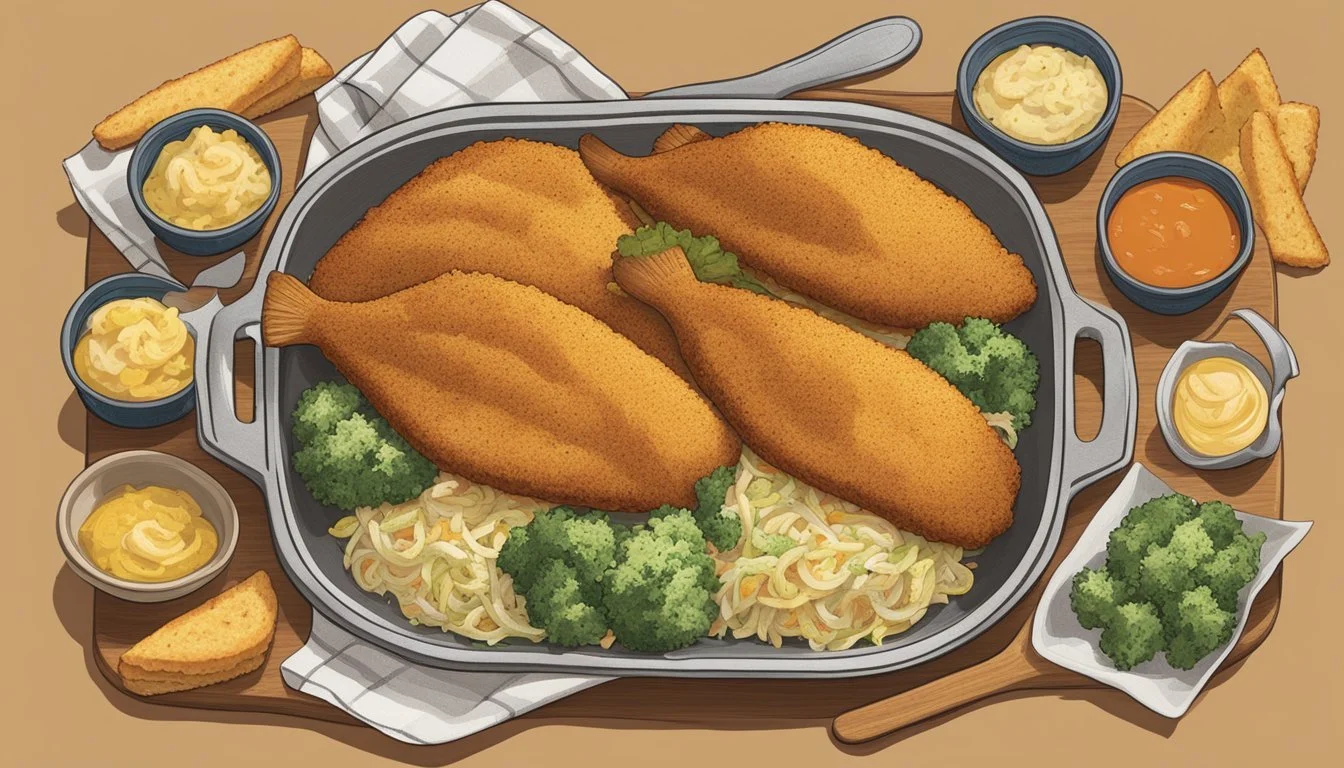How to Prepare a Texas-Style Fish Fry
Your Ultimate Guide
A Texas-style fish (What wine goes well with fish?) fry is a beloved tradition in the southern United States, embodying the spirit and flavors of Texan cuisine. This cooking method, which has been passed down through generations, involves frying fish, usually catfish, to achieve a crispy exterior and succulent interior. The key to this popular dish lies in its seasoning and preparation technique, which sets it apart from other fried fish recipes.
In creating a Texas-style fish fry, the fish is seasoned with a blend of spices and coated in a mixture of flour, cornmeal, and other ingredients to create a flavorful crust. The method typically includes a soak in buttermilk, allowing the flavors to penetrate the fish while tenderizing the flesh. After dredging in the seasoned coating, the fish is fried in hot oil until it reaches the perfect golden brown. This results in a meal that is both hearty and satisfying, with a flavor profile that's as big as the state itself.
The fish used in a Texas-style fry is often sourced locally, adhering to the tradition of using fresh ingredients. Whether hosting a backyard gathering or preparing a family meal, cooking up a Texas-style fish fry is sure to bring people together over a dish that's steeped in Southern hospitality and culinary tradition.
Understanding the Basics of a Fish Fry
A Texas-Style fish fry highlights fresh, locally-sourced fish cooked to golden perfection. It's essential to select the correct type of fish and ascertain its freshness for an authentic taste and satisfying texture.
Selecting the Right Fish
Choosing the appropriate fish is paramount to the success of a fish fry. Typically, white fish (What wine goes well with white fish?) like catfish, tilapia, bass, and flounder are popular choices. They possess a mild flavor and firm texture that holds up well to frying. Catfish is a staple in Texas, appreciated for its hearty flesh and capacity to absorb seasonings. Other varieties like perch and bass offer slightly different flavors and textures but are equally enjoyed. When possible, opt for farm-raised fish, as they are often bred specifically for culinary uses.
Popular Fish Choices for Texas-Style Fish Fry:
Catfish
Tilapia
Bass
Flounder
Perch
Determining Freshness
Freshness is a non-negotiable aspect of sourcing fish for a fry. Fresh fish should have a clean, ocean-like smell without any overly fishy or sour odors. The eyes ought to be clear and bright, not dull or sunken. Gills should be a vibrant red, and the flesh must spring back when pressed. When purchasing farm-raised fish, enquire about the harvest date to ensure it's as fresh as possible.
Freshness Checklist:
Smell: Clean, not fishy
Eyes: Clear and bright
Gills: Vibrant red
Flesh: Firm with a quick bounce-back
Preparing the Fish
Preparing the fish is essential for a successful Texas-style fish fry. The process involves cleaning and filleting the fish, seasoning it to perfection, and creating a flavorful batter that will provide the perfect crunch.
Cleaning and Filleting
One begins by ensuring the catfish fillets are cleaned and patted dry. It's important to remove any excess moisture as it could affect the cooking process. The fillets should be inspected for bones and, if necessary, removed. A sharp fillet knife is crucial to make clean cuts without tearing the flesh.
Seasoning the Fish
Seasoning lays the groundwork for flavor. The catfish fillets should be liberally seasoned with a mix of kosher salt, black pepper, cayenne, lemon zest, and garlic powder to infuse the flesh with a robust Texas-style taste. Sprinkling paprika can add a subtle smokiness and enhance the color of the fish.
Seasoning Mix for Catfish Fillets:
1 tsp kosher salt
1 tsp black pepper
1/2 tsp cayenne pepper
Zest of 1 lemon
1 tsp garlic powder
1 tsp paprika
Gently rub the seasoning mix onto both sides of the fillets and set them aside to marinate briefly.
Creating the Batter
A good batter is thick enough to adhere to the fish but not so heavy as to become soggy. Start with a base of all-purpose flour and yellow cornmeal to create texture. To the dry mixture, add a proportion of cornstarch which will help in achieving a crispy finish. Some choose to incorporate Old Bay seasoning here for an extra kick.
For the wet ingredients, options include milk, buttermilk, egg, and even beer for a lighter batter, or water for simplicity. Whisking these together creates a smooth and consistent batter.
Basic Batter Recipe:
1 cup all-purpose flour
1/2 cup yellow cornmeal
1/4 cup cornstarch
1 tsp Old Bay seasoning (optional)
1 cup buttermilk or beer
1 egg, beaten
Dip the seasoned catfish fillets into the batter to coat them evenly. For an extra layer of texture, fillets can be first dredged in plain flour before dipping into the batter. This helps the batter stick better and results in a battered or breaded exterior once fried.
Selecting Your Cooking Equipment and Oil
To ensure a successful Texas-style fish fry, one must use the appropriate equipment to heat oil safely and efficiently and select an oil that provides the right flavor and cooking properties.
Deep Fryers vs. Dutch Ovens vs. Cast Iron Pans
For a traditional Texas-style fish fry, deep fryers, Dutch ovens, and cast iron pans are the three common types of equipment. Deep fryers offer consistency with built-in thermostats to maintain optimal oil temperatures but require outdoor space and are less traditional. A Dutch oven is a versatile choice, with its thick walls and heavy bottom retaining heat well, making it a solid option for maintaining steady oil temperatures. Cast iron pans also retain heat proficiently, and their high heat tolerance makes them ideal for achieving the crispy texture desired in fried fish. However, capacity can be an issue with pans when cooking for larger groups.
Choosing the Right Oil
Oil temperature and flavor are critical when frying fish. The options, such as vegetable oil, peanut oil, and canola oil cater to different needs:
Vegetable oil: A common choice as it is affordable and has a relatively high smoke point.
Peanut oil: Favored for its high smoke point and slight nutty flavor, making it ideal for frying fish.
Canola oil: Provides a neutral taste and also has a high smoke point suitable for frying.
When selecting oil, consider the smoke point - the temperature at which it begins to smoke and degrade. The oils listed above generally have high smoke points, making them suitable to preheat to around 350°F before adding the fish to ensure a golden brown and crispy exterior without absorbing excess oil. It is important to monitor the hot oil closely to maintain a constant temperature, as fluctuations can lead to an oily or soggy breading.
Frying Technique and Tips
A proper Texas-style fish fry hinges on meticulous oil temperature control, cooking in manageable batches, and evading typical frying errors to ensure fish that's crispy outside and tender inside.
Mastering Oil Temperature
One should not underestimate the importance of maintaining the correct oil temperature when frying fish, which typically ranges between 330°F and 350°F. A kitchen thermometer should be used to monitor the oil’s temperature consistently. If the oil isn't hot enough, the fish will soak up oil and become greasy; if it's too hot, the outside will burn before the inside cooks properly. The right temperature yields a golden, crispy surface while keeping the inside perfectly tender and flaky.
Frying in Batches
Frying fish in batches prevents the pan from overcrowding and ensures the oil temperature does not drop too significantly, which can lead to soggy fish. It’s recommended to:
Place small batches of fish into the hot oil, allowing plenty of space between pieces.
Once in the oil, let the fish become crispy and golden brown before a gentle flip to fry the other side.
After frying, transfer the fish onto a wire rack set over a sheet to drain excess oil. This helps maintain crispiness better than draining on paper towels, which can lead to a steamy environment that softens the crust.
Avoiding Common Mistakes
To avoid common pitfalls in a Texas-style fish fry, one should:
Never add wet or excessively battered fish into the hot oil as it can reduce oil temperature drastically and cause splattering.
Avoid moving the fish too much after placing it in the oil; wait until it’s time to flip. Continuous movement can break the batter and cause the fish to stick to the pan.
Monitor the fish continuously, frying until it reaches the perfect balance of crispy on the outside and flaky inside—overcooking can make it tough, while undercooking it can leave it mushy.
Serving Your Texas-Style Fish Fry
When it comes to a Texas-style fish fry, it’s not just about the fish. The accompaniments and the presentation are vital in making the meal truly authentic and satisfying.
Accompaniments and Side Dishes
A traditional Texas fish fry wouldn’t be complete without a selection of hearty side dishes to complement the crispy, golden main. The following items are staples:
Coleslaw: A tangy, crunchy coleslaw balances the richness of the fried fish.
Hush Puppies: These deep-fried cornmeal balls are a Southern favorite.
French Fries: A batch of hot, crispy fries is almost obligatory at any fish fry.
Onion Rings: Another fried favorite, onion rings offer a sweet and savory crunch.
Collard Greens (how long do collard greens last?): Often simmered with bacon or ham hocks, they provide a flavorful contrast to the meal.
Tartar Sauce: Essential for dipping, it adds a creamy zest.
Lemon Wedges: Freshness is a squirt away; lemon brightens the fish’s flavor.
Side Dish Description Coleslaw Crunchy, creamy salad with a tangy dressing. Hush Puppies Deep-fried cornmeal balls seasoned with onion and spice. French Fries Classic, salty, and crispy. Onion Rings Sweet onions enveloped in a crispy batter. Collard Greens Leafy greens cooked with smoky meats and flavorful broth. Tartar Sauce Creamy dipping sauce with a pickled tang. Lemon Wedges Fresh citrus to enhance the fish’s flavor.
Presentation Tips
Presentation ties the Texas-style fish fry experience together. Here are key tips for presentation:
Serve the fish and sides on a platter or in a basket lined with checkered paper to evoke that rustic, down-home feel.
Keep fried items crispy by draining them well on wire racks or paper towels before serving.
Arrange the sides around the fish to create a visually appealing and easily accessible layout.
Use sauce containers for tartar sauce and condiments to prevent the food from becoming soggy.
By ensuring the sides are as attention-grabbing as the fish itself and taking care in the presentation, one can create an authentic Texas-style fish fry experience that is both visually and gastronomically pleasing.
Health Considerations and Nutrition
When preparing a Texas-style fish fry, one must consider the nutritional content and aim for a balanced meal. This involves being mindful of the cooking methods and ingredients to ensure a healthier outcome.
Calculating Nutritional Content
To accurately calculate the nutritional content of a Texas-style fish fry, one should consider the type of fish used and the ingredients for breading and frying. A typical recipe includes:
Fish: Normally, a mild white fish such as catfish or tilapia is chosen.
Breading: This often contains flour, cornmeal, and various seasonings.
Frying method: Usually involves cooking in oil, which adds to the fat content.
A nutritional breakdown would typically reflect the high-protein content of the fish, along with an increased amount of fats due to frying, and a moderate carbohydrate count from the breading. For an accurate count, one would need to measure the quantities of each ingredient used and account for cooking losses or gains, such as oil absorption.
Tips for a Balanced Meal
To turn a Texas-style fish fry into a balanced meal, one should consider the following adjustments:
Serve with vegetables: Include sides like steamed broccoli, mixed greens, or a fresh salad to increase the meal's vitamin and mineral content.
Opt for healthier fats: Use oils with a higher proportion of unsaturated fats, such as canola or olive oil, and avoid trans fats.
Frying technique: Avoid over-saturation by ensuring the oil is hot enough to prevent the fish from absorbing excess oil. Additionally, allowing the cooked fish to drain on a wire rack rather than paper towels can reduce grease.
Control portions: Serve moderate portions of the fried fish to keep calories in check while still satisfying cravings.
By adhering to these tips, one can enjoy a Texas-style fish fry that is mindful of health considerations without compromising on taste.
Alternative Fish Fry Methods
For those seeking a healthier variation or simply a change from the traditional deep-fried fish, the oven-baked and air fryer methods provide excellent alternatives. These methods offer a way to achieve a crispy texture with significantly less oil.
Oven-Baked Fish Fry
The oven-baked method is an excellent choice for achieving a crispy coating without submerging the fish in oil. To begin:
Ingredients:
Fish fillets (such as catfish or cod)
Bread crumbs or seasoned coating mix
Olive oil or cooking spray
Salt and pepper to taste
Instructions:
Preheat the oven to 425°F (220°C).
Prepare the fish by patting it dry with paper towels. Season the fillets with salt and pepper.
Place the breadcrumbs or seasoning mix in a shallow dish. Press each fillet into the mixture to coat evenly on both sides.
Arrange the coated fish on a wire rack set over a baking sheet. Spray or drizzle with olive oil.
Bake for 12-20 minutes, depending on thickness, or until the fish flakes easily with a fork and the exterior is golden and crispy.
Air Fryer Fish Fry
Air fryers have gained popularity for their ability to mimic the texture of fried food with minimal oil. Here's how to use one for fish:
Ingredients:
Fish fillets (firm varieties work best)
Flour
Eggs
Panko bread crumbs or coating of choice
Seasoning (e.g., paprika, garlic powder, salt, and pepper)
Instructions:
Preheat the air fryer to 390°F (200°C).
Setup dredging station with three shallow dishes: one for flour, one for beaten eggs, and one for Panko mixed with seasoning.
Dredge each fillet in flour, dip in egg, and then press into Panko mixture.
Place the coated fillets in the air fryer basket in a single layer, ensuring they do not touch for even cooking.
Cook for 10-14 minutes, turning halfway through, until the coating is golden brown and the fish is cooked through. Cooking times may vary based on the air fryer model and fillet size.
Both these methods yield a delicious fish fry with less oil and a satisfyingly crispy texture.
Sharing Your Fish Fry Experience
A Texas-style fish fry is an event worth remembering and sharing. Engage your community by showcasing the highlights, from the sizzling fish to the smiling faces around your table.
Leveraging Social Media
Instagram: Craft visually appealing posts for Instagram showcasing the golden-browned fish, using hashtags such as #TexasFishFry to reach a broader audience. Before and after cooking shots, as well as high-quality pictures of the serving table, can tell a compelling story of the day.
Post Timing: Share your images while the event is happening to capture the live excitement.
Stories: Use Instagram Stories to share quick, in-the-moment clips of the frying process or the first bite reactions.
Facebook: Create a Facebook event or album to share your fish fry experience with friends and family. Encourage guests to contribute their pictures and stories to build a collective memory.
Facebook Live: Consider going live during your fish fry to bring distant friends and family into the heart of the action.
Albums: Create a dedicated album post-event to compile all photos and videos in one place.
Twitter: Tweet about your preparation process, share quick tips, or post live updates using concise text and relevant hashtags like #FishFryFun.
Engagement: Use polls to engage followers, asking about their favorite fish or batter recipes.
Retweet: Share guests' tweets to show the event's popularity and reach.
In each post, include a call to action, inviting followers to share their own fish fry experiences and tips. This not only broadens the conversation but also builds a community around the joys of Southern cooking and hospitality.
Safety and Clean-Up
When preparing a Texas-style fish fry, safety is paramount. One must ensure the cooking area is well-ventilated due to the use of hot oil, which can produce vapors. It's crucial to have a fire extinguisher accessible, as oil fires cannot be extinguished with water.
Cooking Precautions:
Heat Management: Maintain the oil temperature between 330-350°F to prevent fires and ensure even cooking.
Careful Handling: Slowly lower the fish into the oil to avoid splashing, which could cause burns.
Cleanup should begin only after the oil has completely cooled. Hot oil poses a burn risk and should not be disposed of in sinks or toilets.
Cleaning Tips:
Oil Disposal: Once cool, pour the oil into a sealable container and dispose of it according to local regulations—never pour oil down the drain.
Surface Cleaning: Wipe down cooking surfaces with a degreasing agent.
Waste Management: Discard any food waste in trash receptacles to prevent attracting pests.
Personal safety gear such as aprons, oven mitts, and long sleeves can prevent oil splatters from reaching the skin.
Safety Equipments:
Item Purpose Apron Protects clothing from oil splatters Oven Mitts Safeguards hands from hot cookware Safety Goggles Shields eyes from oil splatters
They must ensure utensils and cookware are thoroughly cleaned after use to prevent cross-contamination. This task is especially important in Texas-style fish fries where dredging stations and shared utensils are common. Use hot, soapy water for cleaning and sanitize counters with appropriate kitchen cleaners.
Fish Fry Variations and Recipes
It is essential for fish fry enthusiasts to acknowledge the diversity within this culinary tradition. Different regions add unique twists to their recipes, employing local flavors and techniques.
Exploring Regional Twists
Texas-Style Fish Fry: In Texas, catfish often takes center stage, coated in a seasoned cornmeal batter. Ingredients like cayenne pepper and paprika are staples for that signature Southern kick. Texans might also add a side of hushpuppies and coleslaw to round out the meal.
Southern-Style Fish Fry: Southern fish fries typically feature a variety of seafood, including shrimp and oysters, alongside the fish. A common Southern batter includes ingredients such as buttermilk, cornmeal, and Creole seasoning for that authentic taste.
Specialty Fish Fry Recipes
Classic Texas Fish Fry Batter:
Ingredients:
1 cup cornmeal
1 cup all-purpose flour
2 tablespoons Texas-style seasoning (a blend of salt, black pepper, and a touch of chili powder)
2 teaspoons garlic powder
1 teaspoon onion powder
Pinch of cayenne for heat (optional)
Preparation:
Combine dry ingredients with a whisk to ensure even distribution.
Dredge the fish fillets in the mixture until they are well-coated.
Fry in a skillet or deep fryer at 350°F (175°C) until golden brown and cooked through, typically 3-4 minutes per side depending on thickness.
Southern-Style Cornmeal-Crusted Fish:
Ingredients:
1 cup yellow cornmeal
1/2 cup all-purpose flour
1 tablespoon Old Bay seasoning
1 teaspoon kosher salt
1/2 teaspoon freshly ground black pepper
Buttermilk for dipping
Sliced lemon for serving
Preparation:
Mix the cornmeal, flour, Old Bay, salt, and pepper in a bowl.
Dip seafood in buttermilk, then in the cornmeal mixture.
Fry in hot oil (about 365°F) until the crust is crispy and golden, and the seafood is cooked through.
Fish fry recipes can be adapted to the available local seafood and personal taste preferences while maintaining the essence of the celebrated tradition.
Frequently Asked Questions
What kind of fish is best for a Texas-style fish fry?
For a Texas-style fish fry, one should use firm white fish such as catfish, cod, or tilapia. These fish varieties hold up well to frying and have a flavor that complements the traditional seasonings.
How long should fish be marinated in buttermilk?
Fish should be soaked in buttermilk for at least 5 minutes and up to 30 minutes. This process helps to tenderize the fish and adds a tangy flavor that enhances the overall taste.
What oil is recommended for frying the fish?
It is advisable to use an oil with a high smoke point, such as peanut or canola oil, to prevent burning and ensure a crispy exterior.
What are the key ingredients in the breading?
Essential breading ingredients include:
Cornmeal or flour for crispness
Creole seasoning for a Southern kick
Salt for flavor enhancement
How do you ensure the batter sticks to the fish? To secure the batter:
Pat fish dry with paper towels
Dip in batter just before frying
Allow excess to drip off
At what temperature should you fry the fish?
The oil should be heated to approximately 350 degrees Fahrenheit for optimal frying.
What are some tips for achieving crispy fried fish?
Don't overcrowd the fryer to maintain oil temperature
Drain fried fish on a wire rack instead of paper towels
Fry in batches to ensure each piece is evenly cooked
Conclusion
A Texas-style fish fry is a heart-warming culinary tradition that brings together simplicity and flavor. To master this event, they carefully select their fish, typically opting for fresh, local varieties. The key steps include soaking the fish in buttermilk, dredging it in seasoned cornmeal, and frying it at the right temperature until it reaches a golden perfection. With a watchful eye and attentive care, chefs can avoid common pitfalls such as overcooking or oil splatter.
They serve the fish piping hot, often accompanied by sides like hushpuppies, coleslaw, and fries. Accommodating varied palates is achieved by adjusting seasoning levels, ensuring every guest leaves satisfied. The true success of their fish fry lies not only in the flavors but in the shared experience—people gathering around to enjoy hearty food and create lasting memories.
Here are some tips to ensure success:
Temperature Control: Maintain oil at 350°F for ideal crispiness.
Buttermilk Marinade: Soak the fish for at least 5 minutes; they can extend up to 30 minutes for deeper flavor infusion.
Seasonings: Combine salt, pepper, and other desired spices with cornmeal for a robust crust.
Safety: Always handle hot oil with care to prevent accidents.
Sides Selection: Offer a range of sides to complement the main dish and round out the meal.
Presentation: Serve immediately on a platter with lemon wedges and tartar sauce for added zest.











